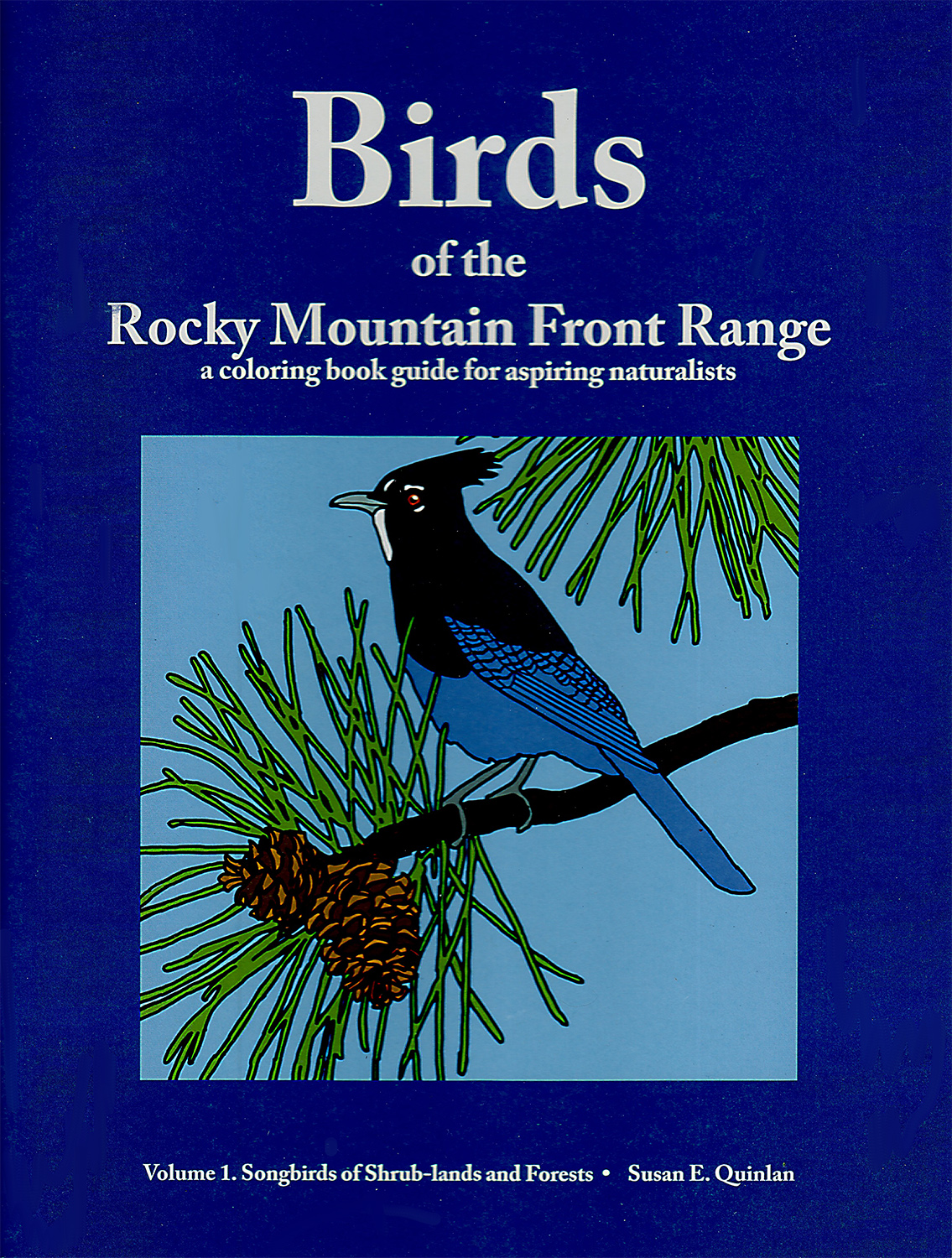
15% Discount on books, cards, and art from my online store.
No worries!! I'll only send occasional updates. And I promise to never share your email address with anyone for any reason.

No worries!! I'll only send occasional updates. And I promise to never share your email address with anyone for any reason.
No mountain hikes, or even flat ground hikes, for me the past couple of months after breaking my left arm when I slipped and fell on the icy hard pavement in a parking lot. Lots of pain and frustration followed. I finally felt up to getting out on a walk on Christmas Day. My arm wasn’t aching quite so badly and the icy trail conditions of the past several weeks had finally abated. What a relief to my spirit to finally get out to soak up the fresh air and the soft brown, gold, purple-gray, and other hues of Colorado’s winter palette.
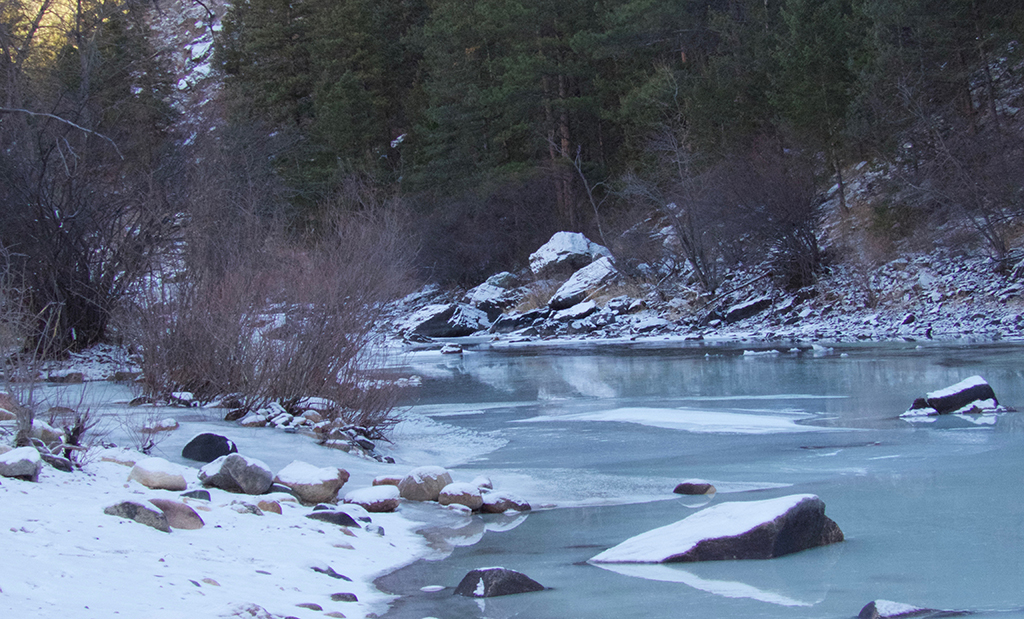
An icy winter day along the Poudre River
We chose our hike destination in hopes of seeing one of my favorite birds, an American Dipper. I saw my first one, when I was a teenager, near a waterfall at the aptly named Ouzel Falls in Rocky Mountain Park. Back then these birds were called Water Ouzels—a far more intriguing name than Dipper, in my opinion. Whatever they are named, these small gray songbirds are fascinating and fun to watch.
In what seems a strange behavior for a songbird, dippers dive and walk underwater in search of food. They eat a variety of stream invertebrates as well as small fish, fish eggs and sometimes tadpoles. American Dippers are one of five species of dippers found in the world. They occur from northern Alaska to Panama, from sea level up to high elevations above treeline. They almost always occur along fast-flowing streams, though I have also seen American Dippers feeding in clear alpine lakes and feasting at a fish hatchery.
I love to see dippers any time of year, but in winter they are especially fun to observe. To find one, you first have to get out where they live. That means getting outdoors, no matter the temperature and snow depth, then spending time in a place where lively, flowing water slices through silent, snowy meadows and hillsides. I find visiting such beautiful places is often reward enough for getting myself out in search of a dipper.
If the bird is standing on a water-washed rock, you may have to look carefully to spot it as the American Dipper’s stone-gray feathers blend in well with river rocks.
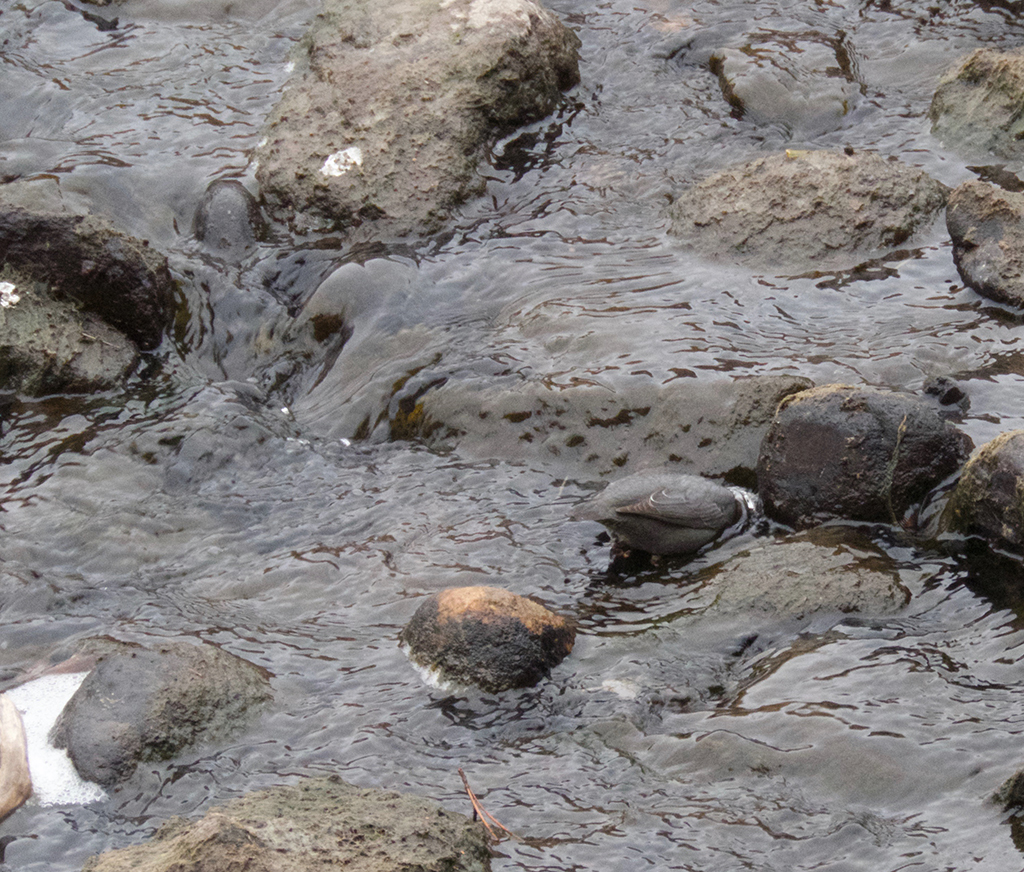
Can you spot the dipper in this photo?
If the bird is standing on an ice shelf, it can be a lot easier to spot. But anytime a dipper is around, a bit of patience and careful watching will reveal its presence, because dippers don’t ever stand still for long.
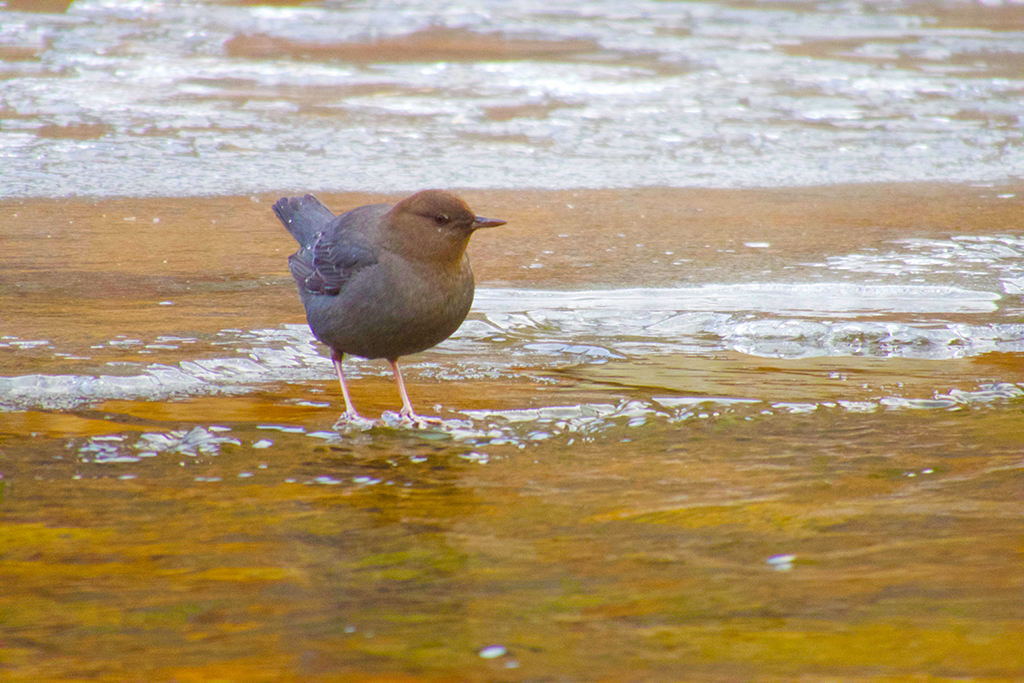
Today, seemingly oblivious to the icicle temperatures of the air and rushing stream water, the dippers we spotted were constantly bobbing up and down. Normal behavior for a dipper. They walked along the ice ledges, hopped atop snow-covered rocks, and plunged headfirst into the icy water.
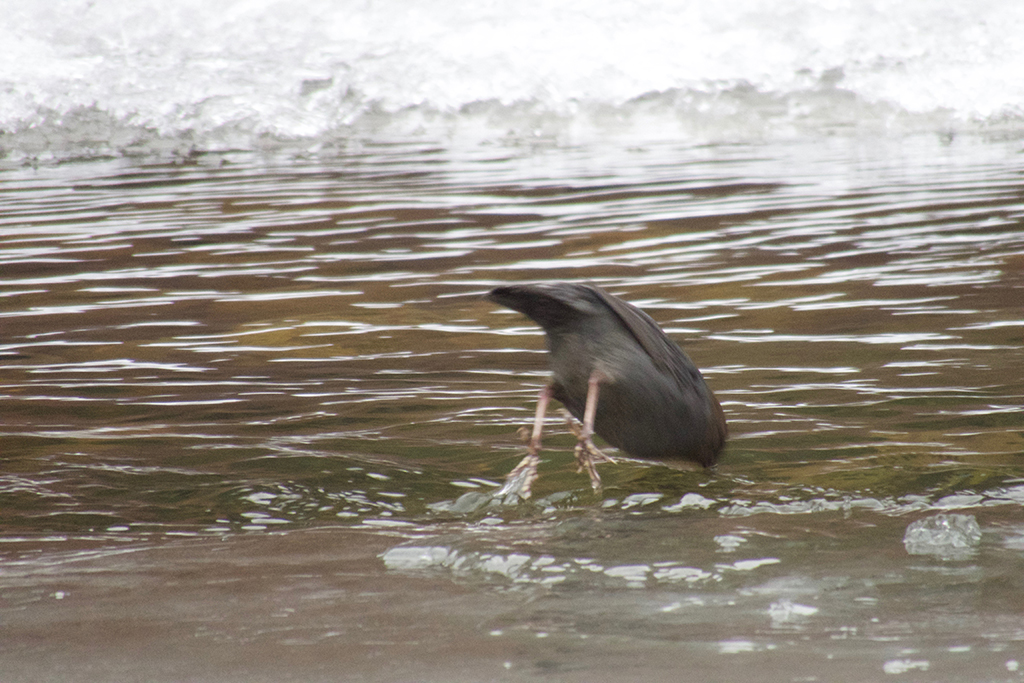
Sometimes the water is clear enough to see them half-walking, half-flying underwater, their wings partially outspread. Then they pop to the surface like corks. The bird may float along with the current like a duck for a moment or two, but usually it hops out, shakes the water from its feathers, then swallows whatever prey it caught.
After a few bobs, perhaps a look or two underwater with only its head submerged, the bird either dives again or flies off to test the waters elsewhere.
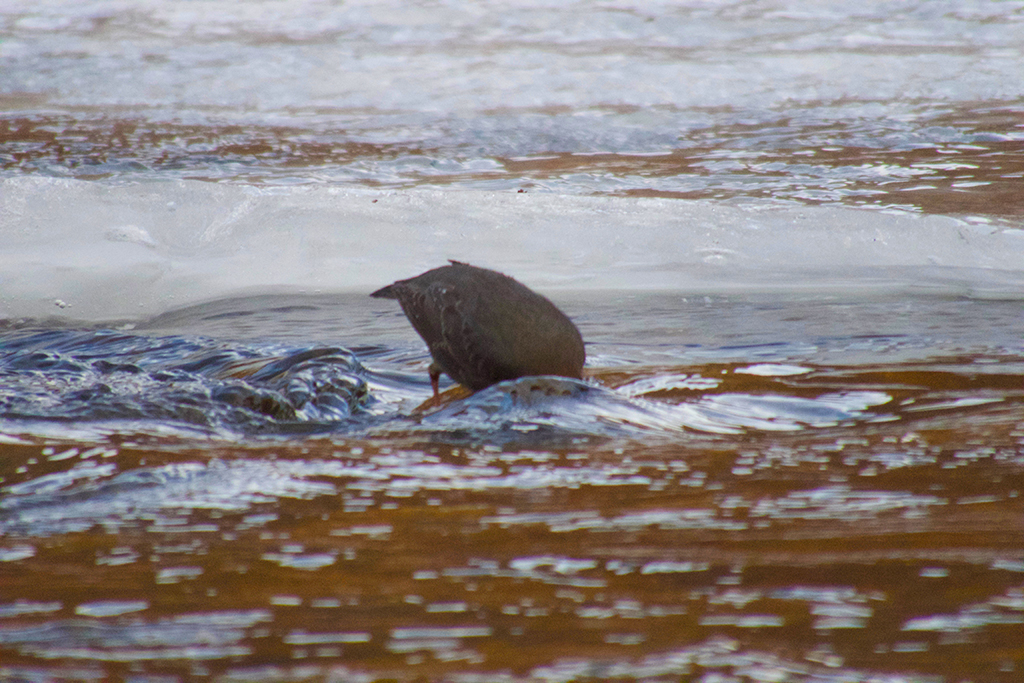
“Hmm. What is there to eat in this fridge?”
Exactly how dippers spot their underwater prey still remains a bit of a mystery to me, but they seem to be quite successful. They do have some adaptations to help then succeed.
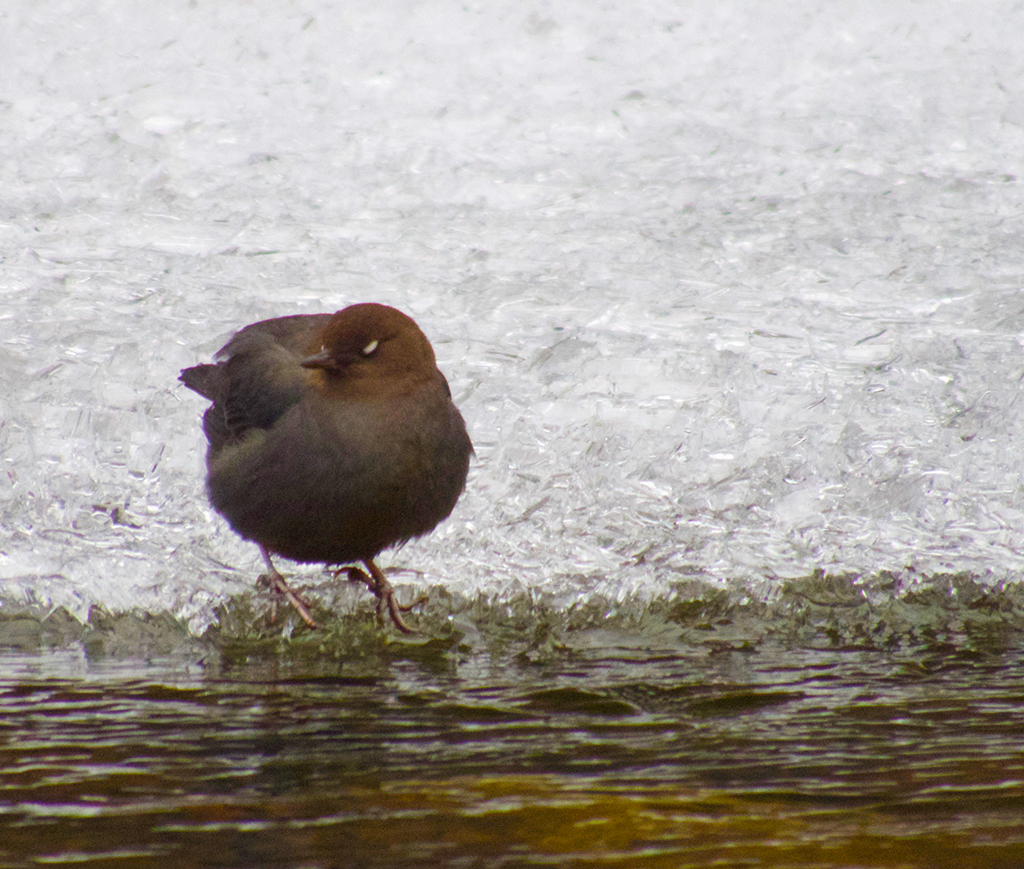
You might guess the white near the eye is the bird’s nictitating membrane. Not so.
The eyelids of a dipper are usually glimpsed when the bird blinks — often right after it surfaces from a dive. As a result, a dipper’s eyelids are often mistaken to be the bird’s nictitating membranes—those extra eyelids all birds have to protect their eyes. It doesn’t make sense that a dipper’s nictitating membranes would be opaque white, however. How would the bird see underwater? In fact, they aren’t opaque or white. Dippers, like other diving birds, have partially transparent nictitating eye membranes. These, presumably, work like a pair of goggles to help the birds see underwater.
Dippers have two other adaptations for diving underwater: a flap that folds over their nostrils to keep the water out and a larger than average oil gland at the base of their tail. This large uropygial gland, up to ten times the size found in similar-sized songbirds, produces enough oil for dippers to keep their soft gray feathers nearly impervious to water. I love seeing the glossy pearls of water roll off a dipper’s back when it emerges from an icy stream.
Dippers live only along fast-flowing, clear streams with abundant benthic macroinvertebrates. That is a fancy biological term for the larvae of mayflies, stoneflies, caddisflies and other critters that live on and under rocks on the bottom of a body of water. The invertebrates dippers feed on require cold water temperatures, low acidity, and clear water that contains little silt. Dippers can’t find enough food in streams where water pollution and sedimentation have depleted the invertebrate numbers. Thus the occurrence of dippers generally indicates that a stream is in good health.
Dippers typically build nests streamside, under large boulders, on cliffs, behind waterfalls, or under bridges. Dippers build a rather large insulated nest covered with a mossy outer layer that helps keep the interior warm and dry. A female may lay up to 5 eggs in a clutch and a pair may nest a second time in some years. Both male and female incubate the eggs for about two weeks then feed the chicks during the next 25 to 27 days until they fledge. Apparently the family group breaks up during winter, with some young following each parent.
The lure of possibly finding a dipper to watch and photograph is one of the ways I motivate myself to get outdoors in the cold and snow during December, January and February. Once I’m dressed appropriately for the weather, I am always glad I got out there—whether I see a dipper or not. But finding a dipper always brings me joy.
Their delightful bobbing along the icy shore and fearless plunge-diving into icy waters brightens even the grayest winter day. By late February or early March Dippers are often beginning courtship. Then their tinkling chortled notes and songs foretell the change of season ahead – and that is news I always welcome.
See more photos, listen to Dipper songs and calls, and learn more about American Dippers (and the other four species of dippers in the world) at the following sites: